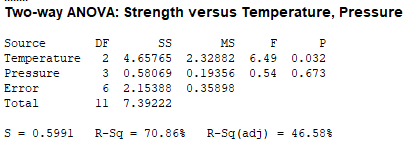Question
In: Statistics and Probability
5.18 The shear strength of an adhesive is thought to be affected by the application pressure...
5.18 The shear strength of an adhesive is thought to be affected by the application pressure and temperature. A factorial experiment is performed in which both factors are assumed to be fixed. Analyze the data and draw conclusions. Perform a test for nonadditivity on minitab.
| Temperature (°F) | ||||
| Pressure (lb/in2) | 250 | 260 | 270 | |
| 120 | 9.60 | 11.28 | 9.00 | |
| 130 | 9.69 | 10.10 | 9.57 | |
| 140 | 8.43 | 11.01 | 9.03 | |
| 150 | 9.98 | 10.44 | 9.80 | |
Solutions
Expert Solution
| Strength | Temperature | Pressure |
| 9.6 | 250 | 120 |
| 9.69 | 250 | 130 |
| 8.43 | 250 | 140 |
| 9.98 | 250 | 150 |
| 11.28 | 260 | 120 |
| 10.1 | 260 | 130 |
| 11.01 | 260 | 140 |
| 10.44 | 260 | 150 |
| 9 | 270 | 120 |
| 9.57 | 270 | 130 |
| 9.03 | 270 | 140 |
| 9.8 | 270 | 150 |
Temperature:
Null Hypothesis: The mean shear strength of an adhesive is the same for all levels of the temperature.
Alternative Hypothesis: The mean shear strength of an adhesive is not the same for all levels of the temperature.
Pressure
Null Hypothesis: The mean shear strength of an adhesive is the same for all levels of the pressure.
Alternative Hypothesis: The mean shear strength of an adhesive is not the same for all levels of the pressure.

Temperature: The p-value for the treatment Temperature is 0.032 and less than 0.05. Hence, we can reject the null hypothesis and conclude that there is a significant effect of temperature on the shear strength of an adhesive.
Pressure:
The p-value for the treatment Pressure is 0.673 and greater than 0.05. Hence, we can not reject the null hypothesis and conclude that there is not a significant effect of pressure on the shear strength of an adhesive.
Related Solutions
For an opened joint with infill materials (i.e. filled joints), its shear strength is affected by...
21. Make a comparison of welding, adhesive joining, and mechanical fastening in regard to bond strength...
low carbon steel having a tensile strength of 350 MPa and shear strength of 250 MPa...
The an article gives the following summary data on shear strength (kip) for a sample of...
NASA is interested in the shear strength of the bond between propellants in a rocket motor...
The shear strength of a normally consolidated clay can be given by the equation f =...
Muscle strength application: Give the definition of muscle strength and describe the main applications of strength...
2. Consider the following observations on shear strength (MPa) of a joint bonded in a particular...
Assume the measurements of nominal shear strength (in kN) are normally distributed. To estimate the mean...
To study the effect of curing temperature on shear strength of a certain rubber compound, 80...
- Mrs. Pringleis a 62-year-old female experiencing diffuse bone pain over the past several years after menopause....
- NEW PROJECT ANALYSIS You must evaluate a proposal to buy a new milling machine. The base...
- 1) Two vectors, r and s lie in the x y plane. Their magnitudes are 4.84 and...
- What artifacts, espoused values, enacted values and norms, and assumptions demonstrate the culture of Southwest Airlines?
- 1) 10000 lb/h of a 40.00% NaoH solution is crystallized through a combined evaporator-crystallizer process. The...
- STRICT DOWNVOTE IF NOT DONE FULLY, WILL REPORT ALSO IF COPY PASTED OR MODIFIED ANSWER Develop...
- The three questions are basically looking for an observation, asking the question and then giving the...
 orchestra answered 3 years ago
orchestra answered 3 years ago